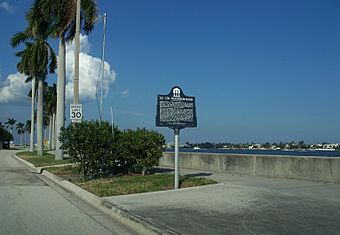El Cid Historic District facts for kids
Quick facts for kids |
|
|
El Cid Historic District
|
|

Historic Marker
|
|
| Location | West Palm Beach, Florida |
|---|---|
| Area | 500 acres (2.0 km2) |
| NRHP reference No. | 95001064 |
| Added to NRHP | August 31, 1995 |
The El Cid Historic District is a special neighborhood in West Palm Beach, Florida. It's a place where many old and important buildings are protected because of their history. This district was officially recognized as a historic place on August 31, 1995. It includes 281 historic buildings and is bordered by Flamingo Drive, South Flagler Drive, Dyer Road, and South Dixie Highway.
Contents
Exploring El Cid: A Historic Florida Neighborhood
First Settlers and Pineapple Farms
Benjamin Lainhart was the first person to live permanently on the western shore of Lake Worth in 1875. He built a cabin in what is now the El Cid area. Before this, the Everglades kept this part of Florida very isolated. There's no sign that Native American tribes like the Jeaga, Tequesta, or Seminole lived here permanently.
In 1876, Lainhart claimed land that covers the northern part of the historic district. Soon after, Elizabeth Wilder settled just south of Lainhart. In 1883, she officially claimed land that includes the southern part of the historic district. Early pioneers bought parts of their land. By 1910, these two large properties were divided into 22 smaller pieces.
Lainhart started the first commercial pineapple farm in the area. Pineapples quickly became the main crop. By the early 1900s, George Matham's Florida Pineapple Company covered most of the historic district with pineapple fields. However, competition from Cuba and plant diseases ruined the pineapple business soon after.
The Roaring Twenties Boom
In 1894, Henry Flagler's railroad arrived, and the Town of West Palm Beach was officially formed. The town's population doubled in the 1900s. It quadrupled in the next ten years, when a few houses were built in the historic district. The El Cid neighborhood mostly grew during the "Land Boom" of the 1920s. During this time, the town's population doubled again.
In the 1920s, a wealthy person named Jay Phipps bought the old pineapple fields and other land. He planned to develop the historic district. Between 1923 and 1926, builders sold expensive homes in the Mediterranean Revival and Mission styles. These homes were built on most of the available lots. Phipps named this development "El Cid" because many homes were built in a Spanish style.
El Cid was named after a famous Spanish hero, Rodrigo Diaz de Bivar (1040-1099). He was a leader who helped conquer Valencia in 1094. The Moors, who were people from North Africa, called him "Cid," which means "lord" in Arabic.
What Makes El Cid Special?
The neighborhood's location, close to downtown and Lake Worth, attracted important business, political, and social leaders. These leaders helped shape the community in the 1920s and 1930s. The economic problems of the Great Depression limited new construction.
After World War II, more houses were built in the empty spaces. However, in the 1960s, many people moved to the suburbs, which made the area less busy. But this slowdown didn't last long.
The El Cid Historic District is recognized on local, state, and national lists of historic places. This means its unique history and architecture are protected for future generations to enjoy.



